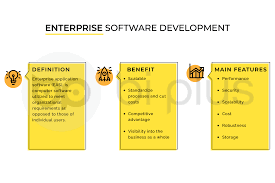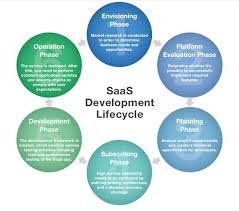Exploring the Innovations in Modern Software Development
The Evolution of Modern Software Development
In today’s fast-paced digital world, software development has undergone a significant transformation. Modern software development practices have revolutionized the way applications are built, deployed, and maintained.
Agile Methodology
One of the key pillars of modern software development is the adoption of agile methodology. Agile emphasizes iterative development, collaboration, and flexibility in responding to change. This approach allows teams to deliver high-quality software products more efficiently and adapt to evolving requirements.
DevOps Integration
DevOps has become an integral part of modern software development processes. By combining development (Dev) and operations (Ops) functions, DevOps promotes automation, collaboration, and continuous integration/continuous delivery (CI/CD). This integration streamlines the software delivery pipeline and enhances overall product quality.
Cloud Computing
Cloud computing has revolutionized how software is developed and deployed. Cloud platforms offer scalability, flexibility, and cost-effectiveness for hosting applications. Developers can leverage cloud services for storage, computing power, and infrastructure-as-code (IaC) to build robust and scalable solutions.
Microservices Architecture
Modern software applications are increasingly adopting a microservices architecture. This approach breaks down complex monolithic applications into smaller, independent services that communicate via APIs. Microservices enable teams to work on different components simultaneously, improve fault isolation, and scale individual services independently.
AI and Machine Learning
The integration of artificial intelligence (AI) and machine learning (ML) technologies is transforming modern software development. AI-powered tools enhance automation, predictive analytics, natural language processing (NLP), and data-driven decision-making. Developers can leverage AI/ML algorithms to optimize performance, personalize user experiences, and automate repetitive tasks.
In conclusion, modern software development is characterized by agility, automation, cloud-native architectures,
microservices,
AI/ML integration,
collaboration,
continuous delivery,
and customer-centricity.
Embracing these trends empowers organizations to innovate rapidly,
deliver value to customers efficiently,
and stay competitive in today’s dynamic market landscape.
By leveraging modern software development practices
businesses can drive digital transformation
accelerate time-to-market
improve product quality
foster innovation
respond quickly to changing market demands
Stay ahead in the digital era.
Understanding Modern Software Development: Key FAQs and Methodologies Explained
- What is modern programming?
- What are modern software engineering practices?
- What are the seven 7 software development methodologies?
- What are the 5 phases of software development?
- What are the 7 phases of software development life cycle?
- What are the top five principles of modern process?
- What are the 6 stages of software development?
- How is modern software built?
- What is the modern software development method?
What is modern programming?
Modern programming refers to the contemporary approach and practices used in software development to create efficient, scalable, and innovative applications. It encompasses the adoption of agile methodologies, DevOps principles, cloud computing services, microservices architecture, and integration of artificial intelligence and machine learning technologies. Modern programming emphasizes collaboration, automation, continuous delivery, and customer-centricity to meet the evolving demands of today’s digital landscape. By embracing modern programming techniques, developers can build robust solutions that drive digital transformation, enhance user experiences, and stay competitive in a rapidly changing technological environment.
What are modern software engineering practices?
Modern software engineering practices encompass a range of methodologies and techniques that have evolved to meet the demands of today’s dynamic digital landscape. These practices include agile development, DevOps integration, continuous integration/continuous delivery (CI/CD), test-driven development (TDD), code reviews, version control systems, and automated testing. By embracing these modern practices, software development teams can achieve greater efficiency, collaboration, quality assurance, and responsiveness to changing requirements. Adopting these practices enables organizations to deliver high-quality software products faster, more reliably, and with enhanced customer satisfaction.
What are the seven 7 software development methodologies?
When it comes to modern software development methodologies, there are several approaches that teams can adopt based on their project requirements and organizational goals. Seven commonly recognized software development methodologies include Agile, Waterfall, Scrum, Kanban, Lean, Extreme Programming (XP), and Spiral. Each methodology offers unique principles and practices to guide the development process, emphasizing factors such as iterative development, customer collaboration, continuous improvement, flexibility in responding to changes, and efficient project management. By understanding the characteristics of these methodologies, teams can choose the most suitable approach to enhance productivity and deliver high-quality software solutions effectively.
What are the 5 phases of software development?
In modern software development, the process typically consists of five key phases: requirements gathering, design, implementation, testing, and maintenance. During the requirements gathering phase, stakeholders define and document the project’s objectives and specifications. The design phase involves creating a blueprint for the software’s architecture and functionality. Implementation is where developers write and code the actual software based on the design specifications. Testing is crucial for identifying and fixing bugs or issues in the software before deployment. Finally, maintenance involves ongoing updates, enhancements, and support to ensure the software remains efficient and effective over time. These five phases form a structured approach to developing high-quality software that meets user needs and business objectives.
What are the 7 phases of software development life cycle?
The software development life cycle consists of seven key phases that guide the process of creating software applications. These phases include planning, requirement analysis, design, implementation, testing, deployment, and maintenance. Each phase plays a crucial role in ensuring the successful development and delivery of high-quality software products. From defining project goals and requirements to coding, testing, and ongoing maintenance, following these structured phases helps teams streamline development processes, manage risks effectively, and ultimately deliver solutions that meet user needs and business objectives.
What are the top five principles of modern process?
Modern software development is guided by several key principles that ensure efficiency, quality, and adaptability. The top five principles include:
- **Agility**: Emphasizing iterative development and flexibility, agile methodologies allow teams to adapt quickly to changing requirements and deliver incremental improvements continuously.
- **Collaboration**: Effective communication and teamwork across cross-functional teams are crucial for aligning goals, sharing knowledge, and ensuring that all stakeholders are on the same page throughout the development process.
- **Automation**: Automating repetitive tasks such as testing, integration, and deployment enhances productivity and reduces human error, allowing developers to focus on more complex problem-solving.
- **Continuous Improvement**: By fostering a culture of ongoing learning and refinement through regular feedback loops and retrospectives, teams can consistently enhance their processes and products.
- **Customer-Centricity**: Keeping the end-user in mind at every stage of development ensures that the final product meets customer needs and expectations, leading to higher satisfaction and better market fit.
Together, these principles form a robust framework for developing high-quality software in today’s fast-paced digital landscape.
What are the 6 stages of software development?
In modern software development, the process typically consists of six key stages: requirements gathering, design, implementation, testing, deployment, and maintenance. During the requirements gathering phase, stakeholders collaborate to define project goals and specifications. The design stage involves creating a blueprint for the software architecture and user interface. Implementation is where developers write the code based on the design specifications. Testing ensures that the software functions correctly and meets quality standards. Deployment involves releasing the software to users or clients. Finally, maintenance involves ongoing support, updates, and improvements to ensure the software remains efficient and effective over time. These six stages are crucial in delivering successful software solutions that meet user needs and business objectives.
How is modern software built?
Modern software development involves a multi-faceted approach that combines innovative methodologies, cutting-edge technologies, and collaborative practices. Typically, modern software is built using agile methodologies that emphasize iterative development, continuous feedback, and adaptive planning. Development teams leverage tools and frameworks for automation, version control, and testing to streamline the development process. Cloud computing plays a crucial role in providing scalable infrastructure for deploying and hosting applications. Furthermore, the adoption of microservices architecture allows for modular design, enabling teams to work on independent components efficiently. Overall, modern software is built through a combination of agile practices, DevOps principles, cloud services, and advanced technologies to deliver high-quality applications that meet evolving user needs.
What is the modern software development method?
The modern software development method primarily revolves around agile practices, which emphasize flexibility, collaboration, and iterative progress. Unlike traditional waterfall models that follow a linear approach, modern methodologies like Agile and Scrum allow for adaptive planning and continual improvement throughout the development process. This approach encourages frequent communication among cross-functional teams, involving stakeholders at every stage to ensure that the final product aligns with user needs and expectations. Additionally, modern methods often incorporate DevOps practices to streamline deployment and operations, enabling continuous integration and delivery (CI/CD). By fostering a culture of responsiveness and innovation, these methods help teams deliver high-quality software more efficiently in today’s fast-paced technological landscape.




